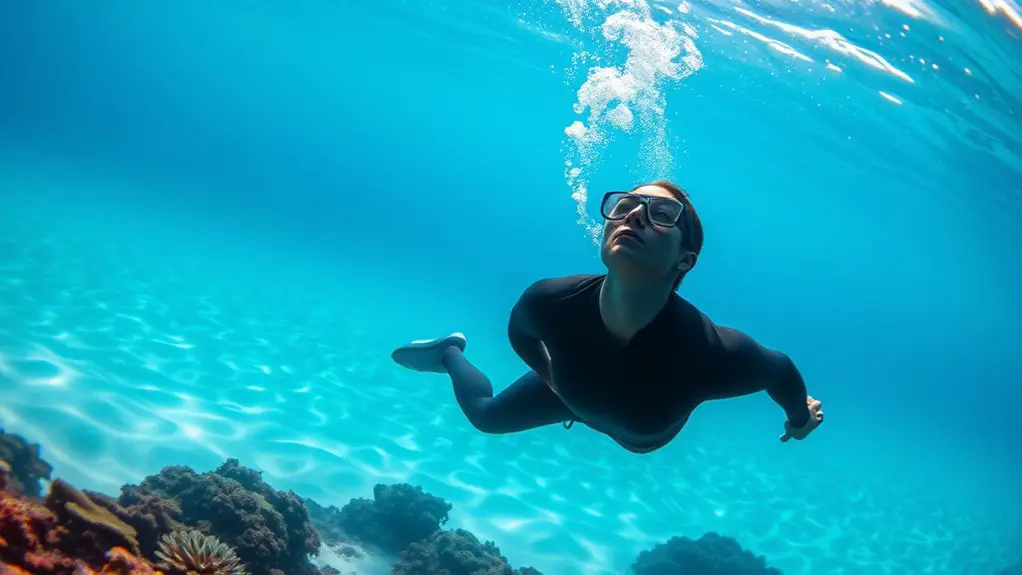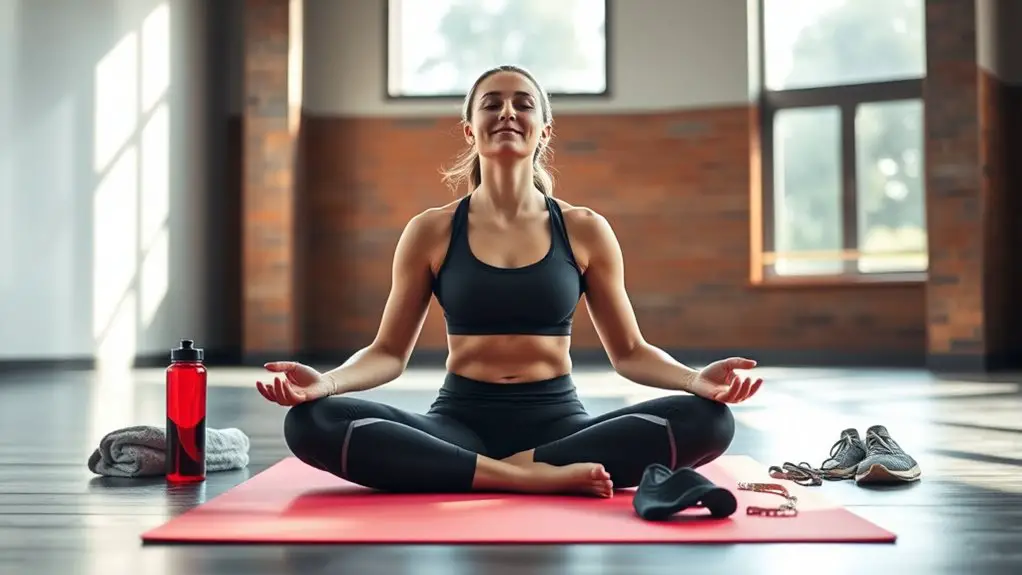To develop breath control for free diving, focus on mastering diaphragmatic breathing to enhance lung capacity and efficiency. Incorporate breath-holding exercises like static and dynamic apnea to boost your confidence underwater. Manage anxiety by practicing grounding techniques and visualization before diving. It's essential to embrace relaxation, as mental calmness greatly improves breath control. Want to explore effective routines and techniques to elevate your skills even further? There's so much more to discover!
Understanding the Importance of Breath Control in Free Diving
When you immerse yourself in free diving, mastering breath control isn't just beneficial—it's essential. It's about embracing the freedom of the underwater world while maintaining breath awareness. By understanding how your body utilizes oxygen, you can enhance your oxygen efficiency, allowing you to dive deeper and longer without the panic of running out of air.
You'll discover that each breath becomes a tool for liberation rather than a limitation. As you practice, you'll learn to slow your heart rate and calm your mind, transforming anxiety into tranquility. This breath control isn't merely a technique; it's a pathway to freedom, letting you explore the ocean depths with confidence.
Ultimately, developing breath control reveals a world of possibilities, allowing you to connect with nature on a profound level. So, take the plunge and embrace the art of breath control—it's your key to revealing the true essence of free diving.
Techniques to Improve Lung Capacity
Improving your lung capacity can considerably enhance your free diving experience. By focusing on lung expansion and diaphragm strengthening, you'll access new depths of freedom underwater. Here are some effective techniques to help you boost your lung capacity:
| Technique | Description |
|---|---|
| Diaphragmatic Breathing | Inhale deeply through your nose, allowing your belly to expand, then exhale slowly. |
| Pursed Lip Breathing | Inhale through your nose, then exhale through pursed lips to control airflow and extend exhalation. |
| Yoga Breathing | Incorporate yoga practices that emphasize deep and controlled breathing to enhance lung function. |
| Interval Training | Engage in high-intensity exercises followed by controlled breathing to improve lung efficiency. |
Breath-Holding Exercises for Divers
Breath-holding exercises are essential for divers looking to enhance their underwater performance and comfort. By practicing these techniques, you'll boost your confidence and extend your time beneath the waves. Here are three effective exercises to incorporate into your training:
- Static Apnea: Find a quiet space, either in water or on land, and hold your breath for as long as you can. Focus on relaxing your body to increase your time.
- Dynamic Apnea: Swim horizontally while holding your breath, simulating the movements you'd make while diving. This will help you get used to breath-holding in real scenarios.
- CO2 Tolerance Tables: Gradually increase the intervals between breaths to build your tolerance to carbon dioxide, essential for longer dives.
Managing Anxiety and Stress While Diving
How can you keep anxiety and stress at bay while diving? First, identify your anxiety triggers. Maybe it's the depth, the dark water, or the pressure. Recognizing these factors is the first step in stress management. When you know what makes you anxious, you can tackle those feelings head-on.
Before you dive, practice grounding techniques. Focus on your breath, feeling each inhale and exhale. Visualize yourself gliding effortlessly through the water, embracing the freedom it offers.
Practice grounding techniques before diving by focusing on your breath and visualizing a graceful journey through the water.
During your dive, if anxiety creeps in, pause and recalibrate. Allow yourself to float and regain your composure. Remember, it's okay to ascend if you need to! Additionally, cultivating mental toughness can help you push through anxiety and enhance your overall diving experience.
Lastly, dive with a buddy or a group. Having a support system can lighten the emotional load. By managing your anxiety and stress, you can truly enjoy the exhilarating experience that free diving brings.
The Role of Relaxation in Breath Control
Relaxation plays an essential role in your breath control, as mental calmness directly impacts how efficiently you manage your breathing. By incorporating techniques for physical relaxation, you can enhance your overall performance and comfort in the water. Let's explore how fostering a relaxed state can elevate your free diving experience.
Importance of Mental Calmness
Achieving mental calmness is essential for effective breath control in free diving. When your mind is at peace, you can better manage your breathing, allowing you to dive deeper and longer. Here are three ways to cultivate that tranquility:
- Mindful Breathing: Focus on your breath, inhaling and exhaling deeply. This practice not only calms your mind but also enhances your lung capacity.
- Visualization Techniques: Picture yourself effortlessly gliding through the water. This mental imagery can reduce anxiety and boost your confidence.
- Embrace Silence: Find moments of stillness, whether above or below the surface, to reconnect with your inner self and foster a sense of freedom.
Techniques for Physical Relaxation
While mental calmness sets the stage, physical relaxation plays an essential role in enhancing your breath control during free diving. You can achieve this through techniques like progressive muscle relaxation, where you systematically tense and then relax each muscle group. Additionally, visualization techniques can help you imagine a serene underwater environment, promoting relaxation and focus.
| Technique | Purpose | Benefits |
|---|---|---|
| Progressive Muscle Relaxation | Reduces tension | Increases overall calmness |
| Visualization Techniques | Enhances mental imagery | Improves focus and control |
| Deep Breathing Exercises | Promotes oxygen efficiency | Aids in relaxation |
Incorporating these techniques into your practice allows you to dive deeper and enjoy the freedom of the underwater world.
Implementing a Breath Control Routine for Training
A consistent breath control routine is essential for enhancing your free diving skills. When you focus on breath timing and rhythmic breathing, you'll find yourself diving deeper and feeling more at peace underwater. Here's how to implement an effective routine:
- Daily Practice: Dedicate at least 10-15 minutes each day to breath control exercises. Experiment with various techniques to find what resonates with you.
- Interval Training: Incorporate breath holds into your workouts. For instance, inhale deeply, hold for a specific count, then exhale slowly. This builds your lung capacity and improves breath timing.
- Mindfulness Meditation: Engage in meditation sessions that emphasize rhythmic breathing. This not only enhances your focus but also calms your mind, allowing for a deeper connection to your breath.
Frequently Asked Questions
How Does Diet Impact Breath Control for Free Diving?
It's interesting how your diet can influence your breath control. By focusing on nutrient timing, you can optimize your energy levels, helping you stay calm and composed underwater. Incorporating the right hydration strategies keeps your body functioning efficiently, ensuring your lungs can expand fully. When you nourish yourself well, you'll find that your breath control improves, granting you the freedom to dive deeper and explore the underwater world with confidence and ease.
What Equipment Can Help Improve Breath Control?
When it comes to improving your breath control, some great equipment can make a difference. Consider using breath training devices that simulate high-altitude conditions, pushing your lungs to adapt. Apnea masks are also fantastic tools, as they help you practice breath-holding in a controlled environment. These tools can enhance your lung capacity and endurance, giving you the freedom to explore deeper and longer. Embrace the journey, and you'll find yourself thriving underwater.
Are There Age Limits for Practicing Breath Control Techniques?
Did you know that around 50% of young people can considerably improve their lung capacity through regular training? When it comes to practicing breath control techniques, age considerations are important. While there's no strict age limit, youth training is often encouraged from a young age, as it can promote better breathing habits and physical fitness. Just remember to verify that the training is safe and suitable for their developmental stage, so they can truly enjoy the freedom of movement.
Can Breath Control Improve Overall Fitness Levels?
Absolutely, breath control can enhance your overall fitness levels. By practicing breath techniques, you're not just improving lung capacity but also increasing your stamina and endurance. These techniques can help you manage stress, which is essential for a balanced life. As you gain better control over your breathing, you'll notice improved performance in various physical activities. So, immerse yourself in those breath techniques, and enjoy the fitness benefits they bring to your freedom!
How Often Should I Practice Breath Control Exercises?
To improve your breath retention, aim to practice breath control exercises at least three times a week. Consistency's key, but listen to your body; if you feel fatigued, give yourself a break. You don't need to spend hours each session—just 15-20 minutes can make a difference. As you progress, you might find yourself craving that freedom in your breathing, allowing you to explore new depths and experiences with ease.




